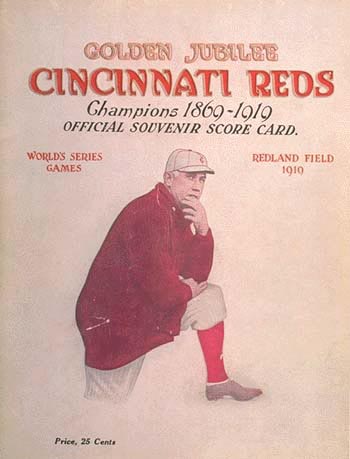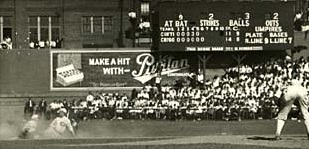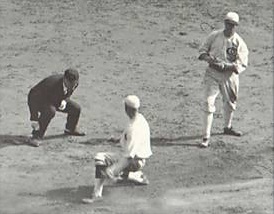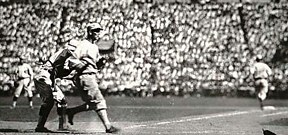

Enter the gamblers. There was no one single mastermind behind the idea of the fix; it was more a collaboration of ideas. Two, however, stand out above the rest: William Thomas "Sleepy Bill" Burns and Billy Maharg. Burns was an ex-major league pitcher and was the connection to the players. Maharg was the gambler with the connections underground. With big money and even bigger dreams, those two men approached two of the White Sox players, Pitcher Ed Cicotte and First Baseman Arnold "Chick" Gandil, about fixing the Series.
The players realized it would take more than just two of them to ensure a proper fix, and, after speaking to a few of their teammates, added six more to their rank: Pitcher Lefty Williams, Centerfielder Happy Felsch, Shortstop Swede Risberg, Thirdbaseman Buck Weaver, Utilityman Fred McMullin, and one of the best and most popular stars ever, Leftfielder "Shoeless" Joe Jackson. In order to pay off eight men, however, Burns and Maharg would need to come up with some more cash, and fast. They hit up "The Big Bankroll" Arnold Rothstein for a much needed loan, along with about half a dozen others. In the end, the gamblers bet nearly half a million dollars on the Reds, while agreeing to pay the players $100,000 to split.
Baseball players salaries were modest in those days -- even for the times -- so, split up, each player was going to take home years' worth of pay. It was a once-in-a-lifetime chance to pad their wallets. Money talks; they listened and were convinced. And so what if it was illegal? No one would ever find out. Unfortunately, that is where they were wrong. A lot of people were needed to raise enough money to make the fix profitable as well as pay off the players, and that meant more people knowing about the scandal. All those people, of course, bet on the Reds, and they also told their friends to do the same. Word got around. Heavy betting, a sudden change in the odds, and loose lips all combined to raise suspicion. According to some accounts, "Shoeless" Joe Jackson told the owner of the White Sox, Charles Comiskey, of the fix and was ignored.
The Series was played, and, despite gallant efforts by the other 17 men on the team, the fix was a success, and the fans couldn't even tell the Series had been thrown. Word continued to spread, and rumors swirled around throughout the next season. Finally, late in 1920, the eight players dubbed the "Black Sox" were indicted.
Above text taken from here













Chicago lost the first game 9-1, but the players didn't receive the $20,000 in cash Gandil had been promised for losing that game. They were willing to lose game two as long as the money came by the end of the next day. Chicago lost 4-2. The Sox players not involved in the fix were beginning to get suspicious. Catcher Ray Schalk knew something was wrong with the pitching. He and manager Kid Gleason reportedly got into fights with Gandil and Williams over their poor performances. After the game, Gandil looked up Abe Attell to collect the $40,000 owed him and his teammates for throwing two games. He received only $10,000. The players were upset and began to have second thoughts about continuing to lose.
Chicago won the third game and many of the gamblers betting on individual games lost a great deal of money. It was Attell's turn to feel betrayed and he refused to pay any more. Sullivan came up with $20,000 before the fourth game and at least some of the traitors were still willing to lose. Cicotte made several errors, and the Reds won 2-0. Chicago lost game five, as well, with a final score of 5-0.
By now the gamblers had missed another payment, and the players had decided there was no reason to lose. At least if they won the Series, they would collect $5,000 each. Chicago won the sixth game 5-4 and the seventh 4-1. The players all seemed to play to the best of their abilities, and the national championship was within their grasp. Unfortunately, any chance of winning was ruined by Arnold Rothstein. Instead of betting individual games, he had bet on Cincinnati to win the series. With his investment at risk, Rothstein sent one of his henchman to visit Williams, who was pitching in the eighth game. He explained to Williams that Rothstein wanted the Series to end the next day. He threatened Williams and his wife. Chicago lost 10-5. In the end, one scared man handed Cincinnati the World Series.
Throughout the Series, Hugh Fullerton, a sports writer for the Chicago Herald and Examiner, had been paying close attention to the rumors of a fix. He hinted about the selling of the Series in his newspaper columns and urged club owners to do something about gamblers' involvement in baseball. Most people didn't believe fixing the World Series was possible. Club owners, who knew better, were afraid the public would turn their backs on baseball if they admitted any wrongdoing, and refused to acknowledge a problem. The entire controversy might have blown over if the problem had not continued to grow. During the 1920 season, players on other teams began to take advantage of gamblers' offers. Widespread rumors surfaced about games being thrown by players from the New York Giants, New York Yankees, Boston Braves, and Cleveland Indians.
For stats of World Series click here
Above text taken from here